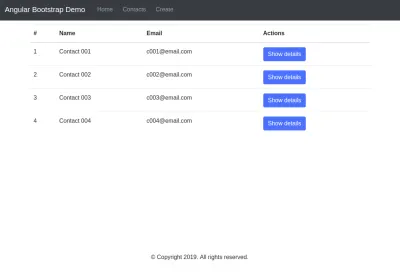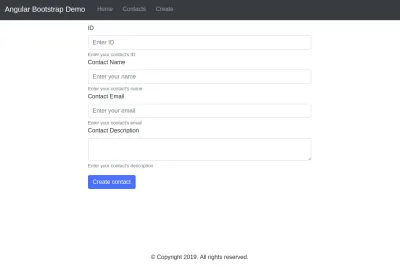使用 Bootstrap 設計 Angular 應用程序
已發表: 2022-03-10如果您已經嘗試使用 Angular 7 構建 Web 應用程序,那麼是時候將它提升一個檔次了。 讓我們看看如何將 Bootstrap CSS 樣式和 JavaScript 文件與使用 Angular CLI 生成的 Angular 項目集成,以及如何使用表單控件和類來創建漂亮的表單以及如何使用 Table 樣式設置 HTML 表格的樣式。
對於 Angular 部分,我們將創建一個簡單的客戶端應用程序來創建和列出聯繫人。 每個聯繫人都有一個 ID、姓名、電子郵件和描述,我們將使用一個簡單的數據服務,將聯繫人存儲在 TypeScript 數組中。 您可以改用高級內存 API。 (查看“Angular 路由的完整指南”。)
注意:您可以從這個 GitHub 存儲庫獲取本教程的源代碼,並在此處查看實時示例。
要求
在我們開始創建演示應用程序之前,讓我們看看本教程所需的要求。
基本上,您將需要以下內容:
- 安裝了 Node.js 和 NPM(您可以直接前往官方網站並為您的系統下載二進製文件),
- 熟悉 TypeScript,
- Angular的工作經驗,
- CSS和HTML的基本知識。
安裝 Angular CLI
讓我們從安裝最新版本的 Angular CLI 開始。 在您的終端中,運行以下命令:
$ npm install -g @angular/cli在撰寫本文時,已安裝 Angular CLI v7.0.3 。 如果您已經安裝了 CLI,則可以使用以下命令確保您擁有最新版本:
$ ng --version創建項目
安裝 Angular CLI 後,讓我們通過運行以下命令使用它來生成 Angular 7 項目:
$ ng new angular-bootstrap-demo然後 CLI 將詢問您:
您想添加 Angular 路由嗎?
按Y 。 接下來,它會問你:
您想使用哪種樣式表格式?
選擇“CSS”。
添加引導程序
創建項目後,您需要安裝 Bootstrap 4 並將其與您的 Angular 項目集成。
首先,在項目的根文件夾中導航:
$ cd angular-bootstrap-demo接下來,從 npm 安裝 Bootstrap 4 和 jQuery:
$ npm install --save bootstrap jquery(在這種情況下,安裝了bootstrap v4.2.1和jquery v3.3.1 。)
最後,打開angular.json文件,將 Bootstrap CSS 和 JS 文件以及 jQuery 的文件路徑添加到build目標下的styles和scripts數組中:
"architect": { "build": { [...], "styles": [ "src/styles.css", "node_modules/bootstrap/dist/css/bootstrap.min.css" ], "scripts": [ "node_modules/jquery/dist/jquery.min.js", "node_modules/bootstrap/dist/js/bootstrap.min.js" ] },查看如何將 Bootstrap 添加到 Angular 6 項目中,了解如何將 Bootstrap 與 Angular 集成。
添加數據服務
創建項目並添加 Bootstrap 4 後,我們將創建一個 Angular 服務,該服務將用於提供一些演示數據以顯示在我們的應用程序中。
在您的終端中,運行以下命令以生成服務:
$ ng generate service data 這將創建兩個src/app/data.service.spec.ts和src/app/data.service.ts文件。
打開src/app/data.service.ts並將其內容替換為以下內容:
import { Injectable } from '@angular/core'; @Injectable({ providedIn: 'root' }) export class DataService { contacts = [ {id: 1, name: "Contact 001", description: "Contact 001 des", email: "[email protected]"}, {id: 2, name: "Contact 002", description: "Contact 002 des", email: "[email protected]"}, {id: 3, name: "Contact 003", description: "Contact 003 des", email: "[email protected]"}, {id: 4, name: "Contact 004", description: "Contact 004 des", email: "[email protected]"} ]; constructor() { } public getContacts():Array<{id, name, description, email}>{ return this.contacts; } public createContact(contact: {id, name, description, email}){ this.contacts.push(contact); } } 我們添加了一個包含一些演示聯繫人的contacts數組、一個返回聯繫人的getContacts()方法和一個將新聯繫人附加到contacts數組的createContact() 。
添加組件
創建數據服務後,接下來我們需要為我們的應用程序創建一些組件。 在您的終端中,運行:
$ ng generate component home $ ng generate component contact-create $ ng generate component contact-list 接下來,我們將這些組件添加到路由模塊以在我們的應用程序中啟用導航。 打開src/app/app-routing.module.ts文件並將其內容替換為以下內容:
import { NgModule } from '@angular/core'; import { Routes, RouterModule } from '@angular/router'; import { ContactListComponent } from './contact-list/contact-list.component'; import { ContactCreateComponent } from './contact-create/contact-create.component'; import { HomeComponent } from './home/home.component'; const routes: Routes = [ {path: "", pathMatch: "full",redirectTo: "home"}, {path: "home", component: HomeComponent}, {path: "contact-create", component: ContactCreateComponent}, {path: "contact-list", component: ContactListComponent} ]; @NgModule({ imports: [RouterModule.forRoot(routes)], exports: [RouterModule] }) export class AppRoutingModule { } 當用戶訪問我們的應用程序時,我們使用路由器路徑的redirectTo屬性將用戶重定向到主頁。
添加頁眉和頁腳組件
接下來,讓我們創建頁眉和頁腳組件:
$ ng generate component header $ ng generate component footer 打開src/app/header/header.component.html文件並添加以下代碼:
<nav class="navbar navbar-expand-md bg-dark navbar-dark fixed-top"> <a class="navbar-brand" href="#">Angular Bootstrap Demo</a> <button class="navbar-toggler" type="button" data-toggle="collapse" data-target="#navbarCollapse" aria-controls="navbarCollapse" aria-expanded="false" aria-label="Toggle navigation"> <span class="navbar-toggler-icon"></span> </button> <div class="collapse navbar-collapse"> <ul class="navbar-nav mr-auto"> <li class="nav-item"> <a class="nav-link" routerLink="/home">Home</a> </li> <li class="nav-item"> <a class="nav-link" routerLink="/contact-list">Contacts</a> </li> <li class="nav-item"> <a class="nav-link" routerLink="/contact-create">Create</a> </li> </ul> </div> </nav> Bootstrap 4 將創建一個導航欄,我們將使用routerLink指令鏈接到不同的組件。
使用.navbar 、 .navbar-expand{-sm|-md|-lg|-xl}和.navbar-dark類來創建 Bootstrap 導航欄。 (有關導航欄的更多信息,請查看 Bootstrap 關於“導航欄”的文檔。
接下來,打開src/app/header/header.component.css文件並添加:
.nav-item{ padding:2px; margin-left: 7px; } 接下來,打開src/app/footer/footer.component.html文件並添加:
<footer> <p class="text-xs-center">© Copyright 2019. All rights reserved.</p> </footer> 打開src/app/footer/footer.component.css文件並添加:
footer { position: absolute; right: 0; bottom: 0; left: 0; padding: 1rem; text-align: center; } 接下來,打開src/app/app.component.html文件並將其內容替換為以下內容:
<app-header></app-header> <router-outlet></router-outlet> <app-footer></app-footer>我們正在使用頁眉和頁腳組件創建一個應用程序外殼,這意味著它們將出現在我們應用程序的每個頁面上。 唯一需要更改的部分是路由器插座中將插入的內容(查看 Angular 網站上的“應用程序外殼”以獲取更多信息)。

添加一個 Bootstrap Jumbotron
根據引導文檔:
“Jumbotron 是一種輕量級、靈活的組件,可以選擇擴展整個視口,以在您的網站上展示關鍵營銷信息。”
讓我們將 Jumbotron 組件添加到我們的主頁。 打開src/app/home/home.component.html文件並添加:
<div class="jumbotron"> <h1>Angular Bootstrap Demo</h1> <p class="lead"> This demo shows how to integrate Bootstrap 4 with Angular 7 </p> <a class="btn btn-lg btn-primary" href="" role="button">View tutorial</a> </div> .jumbotron類用於創建 Bootstrap Jumbotron。
添加列表組件:使用引導表
現在讓我們從數據服務創建一個組件到列表數據,並使用 Bootstrap 4 表來顯示表格數據。
首先,打開src/app/contact-list/contact-list.component.ts文件並註入數據服務,然後在組件初始化時調用getContacts()方法獲取數據:
import { Component, OnInit } from '@angular/core'; import { DataService } from '../data.service'; @Component({ selector: 'app-contact-list', templateUrl: './contact-list.component.html', styleUrls: ['./contact-list.component.css'] }) export class ContactListComponent implements OnInit { contacts; selectedContact; constructor(public dataService: DataService) { } ngOnInit() { this.contacts = this.dataService.getContacts(); } public selectContact(contact){ this.selectedContact = contact; } } 我們添加了兩個變量contacts和selectedContact ,它們保存了一組聯繫人和選定的聯繫人。 還有一個selectContact()方法,它將選定的聯繫人分配給selectedContact變量。
打開src/app/contact-list/contact-list.component.html文件並添加:
<div class="container"> <table class="table table-hover"> <thead> <tr> <th>#</th> <th>Name</th> <th>Email</th> <th>Actions</th> </tr> </thead> <tbody> <tr *ngFor="let contact of contacts"> <td>{{ contact.id }}</td> <td> {{ contact.name }}</td> <td> {{ contact.email }}</td> <td> <button class="btn btn-primary" (click)="selectContact(contact)"> Show details</button> </td> </tr> </tbody> </table> <div class="card text-center" *ngIf="selectedContact"> <div class="card-header"> # {{selectedContact.id}} </div> <div class="card-block"> <h4 class="card-title">{{selectedContact.name}}</h4> <p class="card-text"> {{selectedContact.description}} </p> </div> </div> </div> 我們簡單地遍歷contacts數組並顯示每個聯繫人的詳細信息和一個按鈕來選擇一個聯繫人。 如果選擇了聯繫人,將顯示帶有更多信息的 Bootstrap 4 卡。
這是 Bootstrap 4 文檔中卡片的定義:
“卡片是一種靈活且可擴展的內容容器。 它包括頁眉和頁腳選項、各種內容、上下文背景顏色和強大的顯示選項。 如果您熟悉 Bootstrap 3,卡片將取代我們的舊面板、孔和縮略圖。 與這些組件類似的功能可用作卡片的修飾符類。”
我們使用.table和.table-hover類來創建 Bootstrap 樣式的表格,使用.card 、 .card-block 、 .card-title和.card-text類來創建卡片。 (有關更多信息,請查看表格和卡片。)
添加創建組件:使用引導表單控件和類
現在讓我們向我們的contact-create組件添加一個表單。 首先,我們需要在我們的主應用程序模塊中導入FormsModule 。 打開src/app/app.module.ts文件,從@angular/forms導入FormsModule ,並將其添加到imports數組中:
import { BrowserModule } from '@angular/platform-browser'; import { NgModule } from '@angular/core'; import { AppRoutingModule } from './app-routing.module'; import { FormsModule } from '@angular/forms'; /* ... */ @NgModule({ declarations: [ /* ... */ ], imports: [ BrowserModule, AppRoutingModule, FormsModule ], providers: [], bootstrap: [AppComponent] }) export class AppModule { } 接下來,打開src/app/contact-create/contact-create.component.ts文件並將其內容替換為以下內容:
import { Component, OnInit } from '@angular/core'; import { DataService } from '../data.service'; @Component({ selector: 'app-contact-create', templateUrl: './contact-create.component.html', styleUrls: ['./contact-create.component.css'] }) export class ContactCreateComponent implements OnInit { contact : {id, name, description, email} = {id: null, name: "", description: "", email: ""}; constructor(public dataService: DataService) { } ngOnInit() { } createContact(){ console.log(this.contact); this.dataService.createContact(this.contact); this.contact = {id: null, name: "", description: "", email: ""}; } } 接下來,打開src/app/contact-create/contact-create.component.html文件並添加以下代碼:
<div class="container"> <div class="row"> <div class="col-sm-8 offset-sm-2"> <div> <form> <div class="form-group"> <label for="id">ID</label> <input [(ngModel)]="contact.id" type="text" name="id" class="form-control" placeholder="Enter ID"> <small class="form-text text-muted">Enter your contact's ID</small> <label for="name">Contact Name</label> <input [(ngModel)]="contact.name" type="text" name="name" class="form-control" placeholder="Enter your name"> <small class="form-text text-muted">Enter your contact's name</small> <label for="email">Contact Email</label> <input [(ngModel)]="contact.email" type="text" name="email" class="form-control" placeholder="Enter your email"> <small class="form-text text-muted">Enter your contact's email</small> <label for="description">Contact Description</label> <textarea [(ngModel)]="contact.description" name="description" class="form-control"> </textarea> <small class="form-text text-muted">Enter your contact's description</small> </div> </form> <button class="btn btn-primary" (click)="createContact()">Create contact</button> </div> </div> </div> </div> 我們使用.form-group 、 .form-control類來創建引導樣式的表單(查看“表單”以獲取更多信息)。
我們使用ngModel指令將表單字段綁定到組件的變量。 為了使數據綁定正常工作,您需要為每個表單字段命名。
推薦閱讀: Tamas Piros 使用 Angular 管理圖像斷點
運行 Angular 應用程序
在這一步,讓我們運行應用程序,看看是否一切都按預期工作。 轉到您的終端,確保您位於項目的根文件夾中,然後運行以下命令:
$ ng serve 實時重載開發服務器將從https://localhost:4200地址運行。 打開您的網絡瀏覽器並導航到該地址。 您應該看到以下界面:

如果您導航到“聯繫人”頁面,您應該會看到:

如果您導航到“創建聯繫人”頁面,您應該會看到:

結論
在本教程中,我們看到瞭如何使用 Bootstrap 界面創建一個簡單的 Angular 應用程序。 您可以在 GitHub 上找到完整的源代碼,並在此處查看實時示例。
